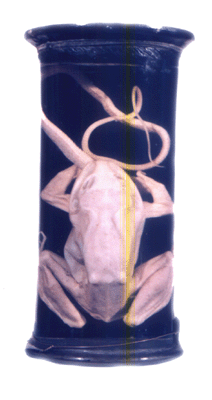 |
 Zoology Zoology


|
Introduction to Zoological Galleries
The Zoological galleries of Government
Museum, Chennai extend over eleven halls, adjoining the Sculpture galleries of the Archaeological
section. In the ground floor galleries, exhibits pertaining to skeletons, dentitions,
integumentary structures, reptiles, birds, mammals and some foreign animals are on display, while
in the first floor galleries, invertebrates and fishes are on display.
Spectacular and outstanding exhibits in the
Zoological galleries are as follows: the largest and most reputed among the exhibits in the
Zoological galleries is the gigantic skeleton of the Great Indian Baleen Whale (Balaenoptera
indica = Balaenoptera musculus) suspended from the centre of the ceiling in the hall of General
Zoological galleries. This skeleton of whale, measuring over 60 feet in length was washed ashore
in Mangalore in 1874 AD. The other notable skeletal exhibits in the museum are the huge skeleton
of the Indian elephant and its skull with tusks, the skeleton of tiger, panther, kangaroo, dugong
and the skeletons of man and horse.
During 1980, old sloping cases were replaced
by modernised show cases in the General Zoology Gallery. All the exhibits were reorganised with
miniature models of animals made of fibreglass materials so as to enable visitors to understand
easily. Although the scope of the collections is limited to South Indian fauna, this museum has
acquired a few birds and mammals from some foreign countries. Among the exhibits in these
galleries, the orangutan, the tapir, the kangaroo, the duck billed platypus, the ostrich, the
cassowary and the macaw parrots are the most outstanding ones. Apart from the few exhibits of
foreign animals, the bulk of the museum collection consists of specimens of indigenous animals,
which will give complete picture of South Indian fauna. Among the reptiles exhibited in the
Reptile Gallery, a huge specimen of leathery turtle, a tortoise from Seychelles, specimens of the
Indian species of crocodiles, a large number of South Indian species of poisonous and
non-poisonous snakes and South Indian species of lizards are important exhibits. In the Bird
Gallery adjacent to the Reptile Gallery, during 1960, the old show cases were replaced by
modernised show cases with concealed lighting. In this gallery complete series of South Indian
birds are arranged systematically in the natural sequence. The most unique and valuable of bird's
collection are a pair of pink-headed ducks.
|


|
 |
In 1988, the Children's Gallery,
accommodated in the mezzanine floor of the new natural history block, was moved to the new
Children's Museum building. Another group of bird collection (Passerine birds) displayed in the
ground floor are shifted to the mezzanine floor of the new natural history block.
Selected examples of some South Indian mammals, aquatic mammals such as
dolphin, dugong and skeletons of tiger, sambar, and the gigantic skeleton of male elephant are on
display in the Mammal Gallery. This male elephant, had killed two men and was eventually, captured
near Chengam, in Tamilnadu in 1887 AD. It was exceptionally a large animal during life
and was 11 feet in height.
In recent years, new
features introduced in the Zoological galleries are displaying animals, as pleasing and attractive
as possible by exhibiting them in the form of illuminated dioramas. Eleven such dioramas were set
up and open to the public in 1999 in the ground floor of the new natural history block.
The spacious hall on the first floor,
directly above the old Mammal Gallery is devoted to the display of Indian fishes. In this gallery,
an enormous specimen of the whale shark is displayed suspending from the ceiling. This specimen is
twenty-two feet long and was captured in Chennai in 1889 AD. The other fishes of the Indian
waters, such as Rayner's shark, the saw fish, tiger shark and the sword fish impress the
visitors by their unusual size and structural peculiarities.
Besides the outstanding exhibits of
Vertebrate animals, the Zoological galleries possess a wealth of materials comprising the lowly
organised Invertebrate animals. The collection of corals exhibited in the front hall of the
Invertebrate Gallery includes a wide range of specimens of various species. The notable exhibits
in the Invertebrate gallery are sacred chank and other molluscan shells, starfishes, sea urchins
and insects.
Besides the exhibited specimens, the
Zoological section possesses a large reserve collection consisting of over a thousand specimens
stored in jars and several hundreds of dry preserved specimens preserved in boxes and
cabinets.
Go to Galleries :
01. Foreign Animals
Gallery
02. Flight in Animals Gallery
03. General Zoology Gallery
04. Reptile Gallery
05. Bird Gallery
06. Mammal Gallery I
07. Mammal Gallery II
08. Coral Gallery
09. Invertebrate Gallery
10. Fish Gallery
11. Amphibian Gallery
|

|
|
|

|
|